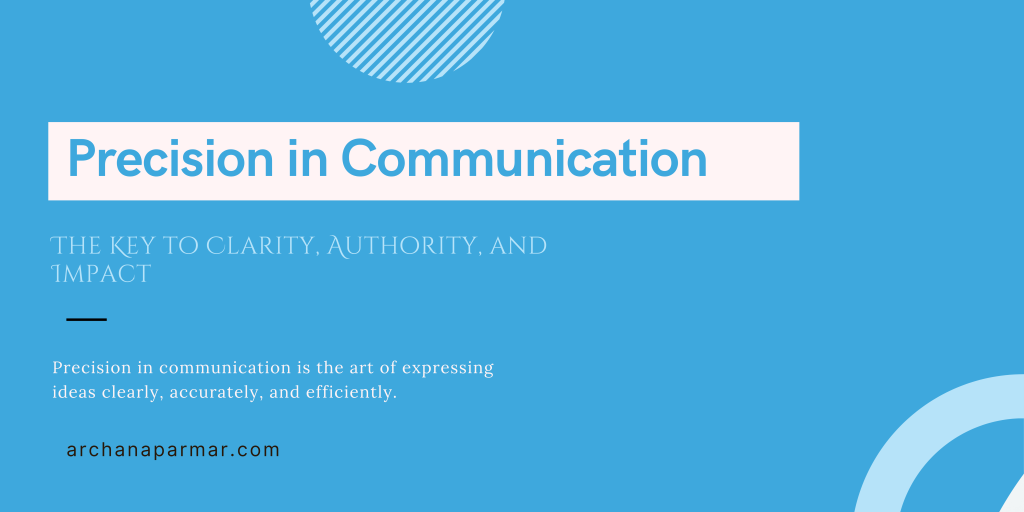Introduction
Precision in communication is the art of expressing ideas clearly, accurately, and efficiently. Whether in writing or speaking, precision ensures that your message is understood exactly as intended. In professional and personal contexts alike, precise communication reduces misunderstandings, fosters credibility, and strengthens connections. This article explores what precision in communication entails, why it matters, and how to cultivate it effectively.
Understanding Precision in Communication
Precision is not about using complex words or sounding sophisticated. It’s about choosing the right words, structuring sentences effectively, and avoiding ambiguity. While verbosity can dilute a message and oversimplification can obscure meaning, precision strikes the perfect balance. Grammar acts as a framework to support precise communication, guiding sentence construction and ensuring clarity.
Example (Written):
- Verbose: “The purpose of this memo is to inform you about the fact that the meeting will be held on Friday at 3 PM in the main conference room.”
- Precise: “The meeting will be held Friday at 3 PM in the main conference room.”
Example (Spoken):
- Verbose: “So what I’m really trying to say here is that we should, you know, maybe reconsider the approach because, at this point, it might not be working as effectively as it could.”
- Precise: “We should reconsider the approach—it’s not working effectively.”
The Impact of Precision on Communication Clarity
Precise language enhances comprehension and minimizes confusion. For instance, ambiguous punctuation or incorrect word choice can completely change the meaning of a sentence. Consider the difference between “Let’s eat, Grandma” and “Let’s eat Grandma.” In professional settings, imprecision can lead to misaligned expectations, errors in execution, and even financial or reputational costs.
Example:
- Imprecise: “We’ll deliver the project soon.” (How soon—days, weeks?)
- Precise: “We’ll deliver the project within five business days.”
Research Insights on Precision and Communication Effectiveness
Studies show that individuals who communicate with grammatical and lexical precision are perceived as more competent and credible. Academic research links precise writing to higher grades, and professional studies highlight that clear, accurate communication correlates with leadership effectiveness. Teams that communicate precisely report fewer misunderstandings and smoother workflow outcomes.
Techniques to Achieve Precision in Communication
- Choosing specific and appropriate words: Avoid vague terms; use words that convey the exact idea.
- Vague: “We need to improve things.”
- Specific: “We need to reduce customer wait times by 20%.”
- Replacing abstract nouns with verbs:
- Abstract: “We made a decision about implementation.”
- Precise: “We decided to implement the plan.”
- Organizing thoughts logically: Structure ideas so they flow naturally and are easy to follow.
- Editing and revision: Review your work critically to eliminate redundant or ambiguous language.
Practical Strategies for Speaking and Writing with Precision
- Know your audience: Tailor language to their understanding, avoiding unnecessary jargon.
- Example: Instead of telling a non-technical audience, “We’ll refactor the backend architecture,” say, “We’ll reorganize the system to make it run faster and more reliably.”
- Use structure: Headlines, bullet points, and short sentences increase clarity.
- Avoid unnecessary complexity:
- Complex: “The overarching objective of this initiative is the maximization of organizational efficiency through the systematic reduction of redundant processes.”
- Simple: “This initiative aims to improve efficiency by reducing redundant processes.”
- Use repetition strategically: Reinforce key points without overloading the audience.
- Example: In a presentation: “The key takeaway is simple: we need focus. Focus on customers. Focus on quality. Focus on delivery.”
Benefits of Precision in Communication
- Credibility and professionalism: Clear expression signals competence.
- Audience engagement and trust: Precision shows respect for the listener’s time and understanding.
- Reduced errors and misinterpretations: Accurate messages minimize costly mistakes.
- Enhanced leadership and teamwork: Precise communication aligns teams and drives action.
Conclusion
Precision is both an art and a skill that can be learned and refined. By cultivating precise communication, you enhance clarity, credibility, and impact—qualities essential for professional success and personal growth. Make precision a habit, and your messages will resonate more powerfully with every audience.
Final Example (Leadership Context):
- Verbose: “So, what we’re going to try to do over the next quarter is focus more of our attention and resources on the customer experience, because that’s something we haven’t really done enough of in the past, and it’s starting to show in our numbers.”
- Precise: “Next quarter, we’ll prioritize customer experience to strengthen results.”

